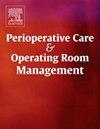利多卡因用于头肢伤口麻醉的给药技术:注射与局部应用
IF 1
Q2 Nursing
Perioperative Care and Operating Room Management
Pub Date : 2025-02-19
DOI:10.1016/j.pcorm.2025.100483
引用次数: 0
摘要
目的:多卡因是在不同形式和各种临床环境中使用最多的麻醉剂之一。近年来,关于利多卡因的最佳给药方式一直存在争议,在不同的临床领域也有比较皮下和外用利多卡因的研究。本研究旨在比较局部注射和皮下注射利多卡因对头部和四肢溃疡患者的影响。方法该单中心横断面研究于2016年4月至2017年4月在伊朗大不里士伊玛目礼萨医学教育中心进行,纳入了3厘米以下四肢撕裂伤患者,排除了咬伤、关节或耳部损伤、特殊药物、心脏或神经病史和癫痫的病例。获得了伦理批准和知情同意。数据由训练有素的采访者通过问卷收集。根据临床实践,患者接受局部或皮下利多卡因治疗,没有随机分组。疼痛采用100毫米视觉模拟量表(VAS)测量。数据分析采用SPSS v22.0,显著性设为p <;0.05和80%的研究力。结果305例患者中,162例皮下注射利多卡因,143例外用利多卡因。年龄、性别差异无统计学意义(P = 0.25、P = 0.86)。局部使用利多卡因的患者报告了更高的起始疼痛,而皮下使用利多卡因的患者在给药和缝合过程中经历了明显更多的疼痛(P <;0.05),突出利多卡因应用方式对患者疼痛体验的影响。结论两种方法给药时疼痛感差异有统计学意义和临床意义,缝合时疼痛感差异有统计学意义但无临床意义。这些发现表明,局部利多卡因提供了一种比皮下注射更少痛苦的选择,特别是在给药期间。本文章由计算机程序翻译,如有差异,请以英文原文为准。
Lidocaine administration techniques for head and limb wound anesthesia: Injection vs. topical application
Purpose
Lidocaine is one of the most utilized anesthetics used in different forms and various clinical contexts. Recently there have been controversy about the best method of lidocaine administration and there have been studies comparing subcutaneous and topical lidocaine in different clinical fields. The present study aims to compare the effect of topical and subcutaneous injection of lidocaine in patients presenting with ulcerations in their head and extremities.
Methods
This single-center cross-sectional study, conducted from April 2016 to April 2017 at Imam Reza Medical Educational Center, Tabriz, Iran, included patients with extremity lacerations under 3 cm, excluding cases with bites, joint or ear injuries, specific medications, cardiac or neuropathic histories, and epilepsy. Ethical approval and informed consent were obtained. Data were collected via questionnaires by trained interviewers. Patients received either topical or subcutaneous lidocaine as per clinical practice, without randomization. Pain was measured using a 100-mm visual analogue scale (VAS). Data analysis utilized SPSS v22.0, with significance set at p < 0.05 and 80 % study power.
Results
In this observational study of 305 patients, 162 received subcutaneous lidocaine and 143 received topical lidocaine. No significant differences in age or gender were found (P = 0.25 and P = 0.86). Patients with topical lidocaine reported higher starting pain, while those receiving subcutaneous lidocaine experienced significantly more pain during administration and suturing (P < 0.05), highlighting the impact of lidocaine application methods on patient pain experiences.
Conclusion
The difference in pain during administration between the two methods was statistically and clinically significant, while the difference in pain during suturing was statistically significant but not clinically meaningful. These findings suggest that topical lidocaine offers a less painful alternative to subcutaneous injection, particularly during administration.
求助全文
通过发布文献求助,成功后即可免费获取论文全文。
去求助
来源期刊

Perioperative Care and Operating Room Management
Nursing-Medical and Surgical Nursing
CiteScore
1.30
自引率
0.00%
发文量
52
审稿时长
56 days
期刊介绍:
The objective of this new online journal is to serve as a multidisciplinary, peer-reviewed source of information related to the administrative, economic, operational, safety, and quality aspects of the ambulatory and in-patient operating room and interventional procedural processes. The journal will provide high-quality information and research findings on operational and system-based approaches to ensure safe, coordinated, and high-value periprocedural care. With the current focus on value in health care it is essential that there is a venue for researchers to publish articles on quality improvement process initiatives, process flow modeling, information management, efficient design, cost improvement, use of novel technologies, and management.
 求助内容:
求助内容: 应助结果提醒方式:
应助结果提醒方式:


